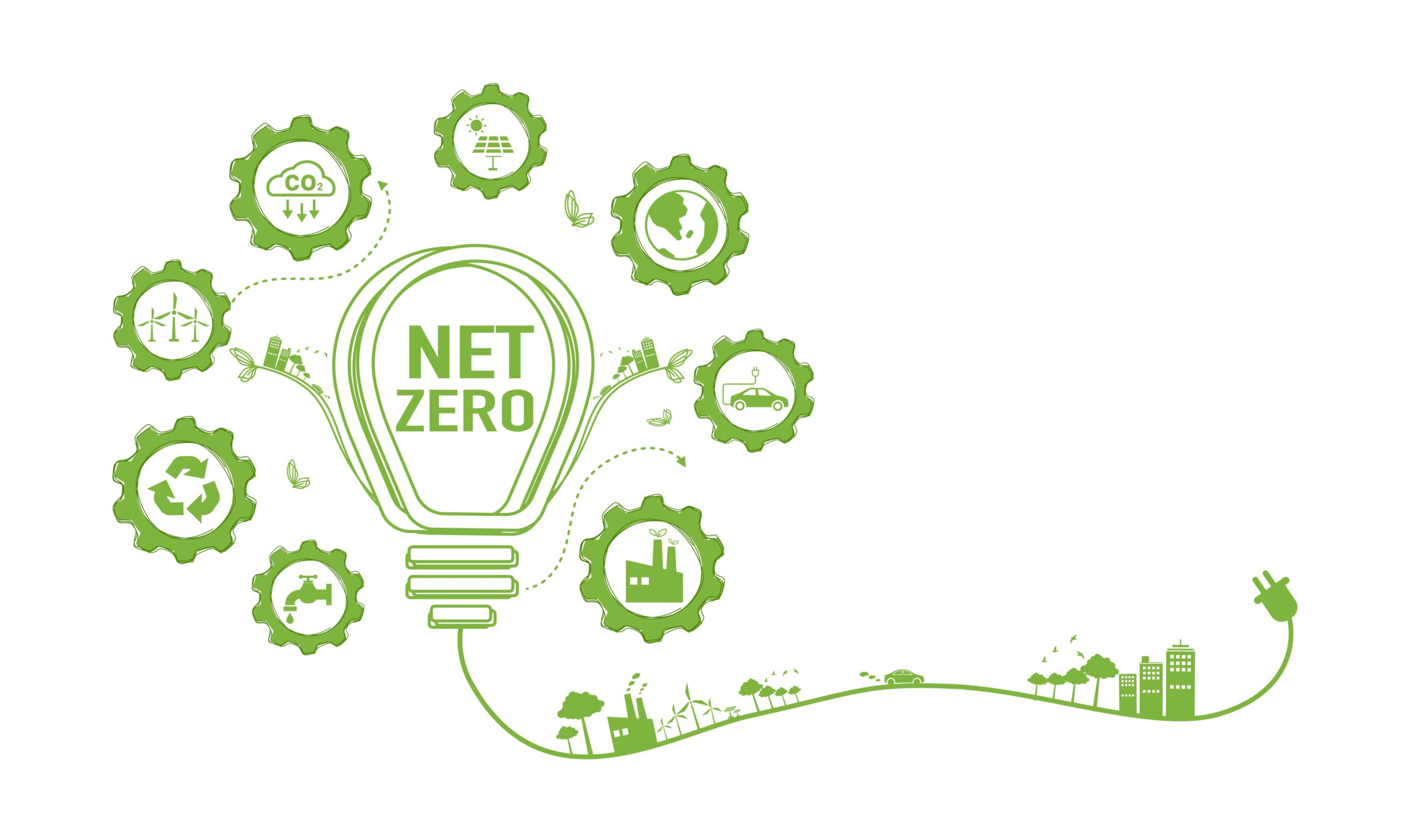In today’s world, the conversation around climate change and environmental sustainability is more critical than ever. You might have heard the term “Net Zero Emission” being mentioned in the news, on social media, or in discussion around environmental policies. But what does it really mean, and why is it so important for our planet and future generations?
This article aims to demystify the concept of Net Zero Emission, explore its global and environmental significance, and delve into practical strategies for achieving it. We’ll also take a closer look at how Suryacipta, a well-experienced developer and management of industrial estate and smart city, is pioneering efforts to reach this ambitious goal. Join us as we unravel the path to a sustainable future, one step at a time.
Definition and Importance of Net Zero Emissions
What is Net Zero Emission?
Net Zero Emission refers to achieving a balance between the greenhouse gases put into the atmosphere and those taken out. Imagine it as a scale where both sides need to be equal. On one side, you have emissions from cars, factories, and other sources. On the other, you have actions that remove carbon dioxide from the air, like planting trees or using technology to capture carbon. The goal is to make sure the amount of gas going into the air is no more than the amount being removed. When these two are in balance, we achieve net zero emissions.
Why is it Important?
You might wonder why reaching net zero is so crucial. The answer lies in its impact on our planet’s climate. Greenhouse gases, like carbon dioxide, trap heat in the atmosphere, leading to global warming and climate change. This results in more extreme weather, melting ice caps, rising sea levels, and loss of wildlife habitats. By striving for net zero emissions, we aim to halt the increase in global temperatures, making the Earth a safer, more stable home for all its inhabitants.
Achieving net zero emissions is not just about protecting the environment. It’s also about securing a sustainable future for the next generations. It ensures that we can continue to grow our economies, live our lives, and enjoy our planet without causing irreversible damage. Essentially, it’s about taking responsibility for our planet today to ensure a healthier, more vibrant Earth tomorrow.
Read More The 6 Leading Trends Revolutionizing Indonesia’s Manufacturing Sector
Global and Environmental Impact of Achieving Net Zero Emission
When we talk about achieving net zero emissions, we’re looking at a goal that has far-reaching impacts, not just on our environment but on global health, economies, and the well-being of every community around the world. You might wonder, how does reaching net zero emissions makes such a significant difference. Let’s break it down.
Firstly, achieving net zero emissions means we’re actively working to reduce the amount of greenhouse gases we release into the atmosphere to the point where we’re adding no more than we’re able to remove. This balance is crucial because these gases, like carbon dioxide and methane, trap heat in our atmosphere, leading to global warming and climate change.
The environmental benefits of reaching net zero are profound. It would lead to cleaner air, as fewer pollutants from fossil fuels would mean a reduction in smog and airborne particles that can harm human health. Wildlife and natural habitats would also stand a better chance of survival, as we’d be slowing down the changes that disrupt ecosystems, like rising temperatures and changing precipitation patterns.
On a global scale, achieving net zero emissions is essential for mitigating the worst impacts of climate change. This includes extreme weather events such as hurricanes, droughts, and heatwaves, which are becoming more frequent and severe as global temperatures rise. By working towards net zero, we’re not just protecting the planet but also safeguarding our economies from the costs associated with these disasters, from rebuilding communities to supporting agriculture and water resources.
In essence, striving for net zero emissions is about ensuring a sustainable and livable planet for future generations. It’s about taking responsibility for our environmental impact and making concerted efforts to preserve the world’s natural beauty and resources. The journey to net zero is challenging, but its global and environmental benefits make it a goal well worth pursuing.
Strategies for Achieving Net Zero Emission
Achieving Net Zero Emissions is a monumental task that requires concerted efforts across multiple fronts. Here, we outline four key strategies that are critical in the journey towards a sustainable future.
1. Transition to Renewable Energy Sources
The heart of the net zero mission lies in moving away from fossil fuels to embrace renewable energy sources such as solar, wind, hydro, and geothermal power. This shift not only reduces greenhouse gas emissions but also harnesses the power of nature to fuel our daily lives. For instance, countries like Denmark and companies like Google have made significant strides in this direction, showcasing that a sustainable energy future is within reach. These case studies serve as beacons of success, proving that transitioning to renewable energy is not only feasible but also beneficial for the economy and the environment.
2. Energy Efficiency and Conservation
Another cornerstone strategy is enhancing energy efficiency and promoting conservation across all sectors, including buildings, manufacturing, and transportation. Simple measures like upgrading to LED lighting, optimizing heating and cooling systems, and implementing strict energy management protocols can lead to substantial reductions in energy consumption and emissions.
The adoption of energy management systems and regular audits are crucial in identifying inefficiencies and implementing corrective actions. This approach not only contributes to emission reduction goals but also results in significant cost savings over time.
3. Carbon Offsetting and Sequestration
To balance the emissions that are harder to eliminate, carbon offsetting and sequestration play a vital role. This involves investing in projects that reduce emissions elsewhere, such as reforestation or afforestation, and technologies that capture carbon directly from the air. These efforts complement the reduction strategies by neutralizing the impact of residual emissions, making them an essential component of the net zero equation. Projects like the Great Green Wall in Africa or advancements in carbon capture and storage (CCS) technology exemplify how we can effectively offset and sequester carbon on a large scale.
4. Innovation and Sustainable Practices
Finally, the role of innovation and the adoption of sustainable practices across industries cannot be overstated. Technological advancements are paving the way for cleaner industrial processes, more efficient transportation solutions, and smarter waste management systems. For example, electric vehicles (EVs) are revolutionizing the transportation industry by significantly reducing emissions compared to traditional combustion engines.
Similarly, in manufacturing, the use of circular economy principles—where materials are reused and recycled—minimizes waste and reduces the demand for new raw materials. These innovations and practices not only contribute to reducing emissions but also foster a more sustainable and resilient economy.
By embracing these strategies, we can make significant strides towards achieving Net Zero Emissions. It’s a journey that requires the collaboration of governments, industries, communities, and individuals. Each step forward is a step towards a healthier planet and a sustainable future for all.
The Role of Industries and Corporations in Mitigating Climate Change
Industries and corporations play a pivotal role in the global effort to combat climate change. As major contributors to greenhouse gas emissions, their actions can significantly impact our planet’s health. But beyond their responsibility, they hold the power to drive substantial positive change. Let’s explore how businesses can be at the forefront of mitigating climate change.
Firstly, industries can lead by example in reducing carbon footprints through operational changes and adopting renewable energy sources. By shifting towards solar, wind, or hydropower for their energy needs, companies not only reduce their emissions but also inspire others to follow suit. Google and Apple, for instance, have committed to powering all their operations with 100% renewable energy, setting a benchmark for others.
Secondly, investing in energy efficiency is both economically and environmentally beneficial. Simple steps like optimizing energy use in manufacturing processes, improving building insulation, and using energy-efficient appliances can significantly cut emissions. Moreover, these measures often result in cost savings, proving that sustainability can enhance profitability.
Furthermore, corporations have the resources to invest in research and development of new technologies that can reduce emissions, improve energy efficiency, or even remove carbon from the atmosphere. Innovations like carbon capture and storage (CCS), electric vehicles, and sustainable agriculture practices are crucial in the fight against climate change.
Corporate responsibility also extends to the supply chain. Companies can demand higher environmental standards from their suppliers, encouraging a ripple effect of sustainability practices across industries. Walmart’s Project Gigaton aims to remove one gigaton of emissions from its supply chain by 2030, demonstrating the power of corporate influence.
Lastly, industries and corporations can advocate for climate-friendly policies and regulations. Their significant economic impact gives them a powerful voice in policy discussions. By supporting legislation that promotes renewable energy, carbon pricing, and emission reductions, businesses can help shape a sustainable future.
In conclusion, industries and corporations have a critical role in mitigating climate change. Through leadership in sustainability, investment in innovation, and advocacy for environmental policies, they can drive the global transition towards a net-zero emissions future. Your actions matter, and together, we can make a difference.
Read More The Road to Sustainability: An In-depth Look at Electric Vehicle Production
Suryacipta Manifestation to Achieve Net Zero Emissions in the Industrial Sector
Suryacipta stands as a beacon of sustainability within the industrial sector, demonstrating a profound commitment to achieving Net Zero Emissions. Let’s delve into how Suryacipta is turning this ambitious goal into reality.
1. Overview of Suryacipta’s Commitment to Sustainability
Suryacipta is a visionary entity with a clear mission to lead the way in environmental sustainability. With a robust set of sustainability goals, Suryacipta is dedicated to reducing its carbon footprint and paving the way for a greener future. This commitment is not just about compliance; it’s about responsibility towards the planet and future generations.
2. Transitioning to Renewable Energy
A cornerstone of Suryacipta’s strategy is its shift towards renewable energy. By launching specific renewable energy projects and forming partnerships with green technology providers, Suryacipta is steadily reducing its reliance on fossil fuels. Investments in solar panels and other renewable sources are not just business moves; they’re part of a larger vision to energize operations sustainably.
Seize Opportunity With Suryacipta

In the heart of the industrial revolution, Suryacipta stands as a gateway to unparalleled opportunities. For businesses looking to thrive in a sustainable and innovative environment, Suryacipta offers prime industrial land that is more than just a space. It’s an invitation to be part of a forward-thinking community dedicated to environmental stewardship and cutting-edge manufacturing practices.
By choosing Suryacipta, you’re not just selecting a location for your operations; you’re making a strategic decision to align with sustainability, efficiency, and growth. This is your chance to position your business at the forefront of the industrial sector’s transformation towards a greener and more sustainable future.
The Future of Manufacturing in Subang Smartpolitan

Subang Smartpolitan represents the next chapter in manufacturing—a vision of a smart, green, and sustainable city. Subang Smartpolitan is designed to be an integrated township where innovation flourishes, sustainability is a priority, and businesses can grow in harmony with the environment. This future-focused industrial city integrates the latest in smart technology, green infrastructure, and community living to create an ecosystem that supports not just the manufacturing needs of today but also the evolving demands of tomorrow.
In Subang Smartpolitan, businesses will find themselves in a dynamic environment where they can innovate, collaborate, and contribute to a sustainable industrial future. Joining Subang Smartpolitan is more than an investment in land; it’s an investment in the future of manufacturing.
Read More Eco-Conscious Industrial Parks: Paving the Way to Sustainability


